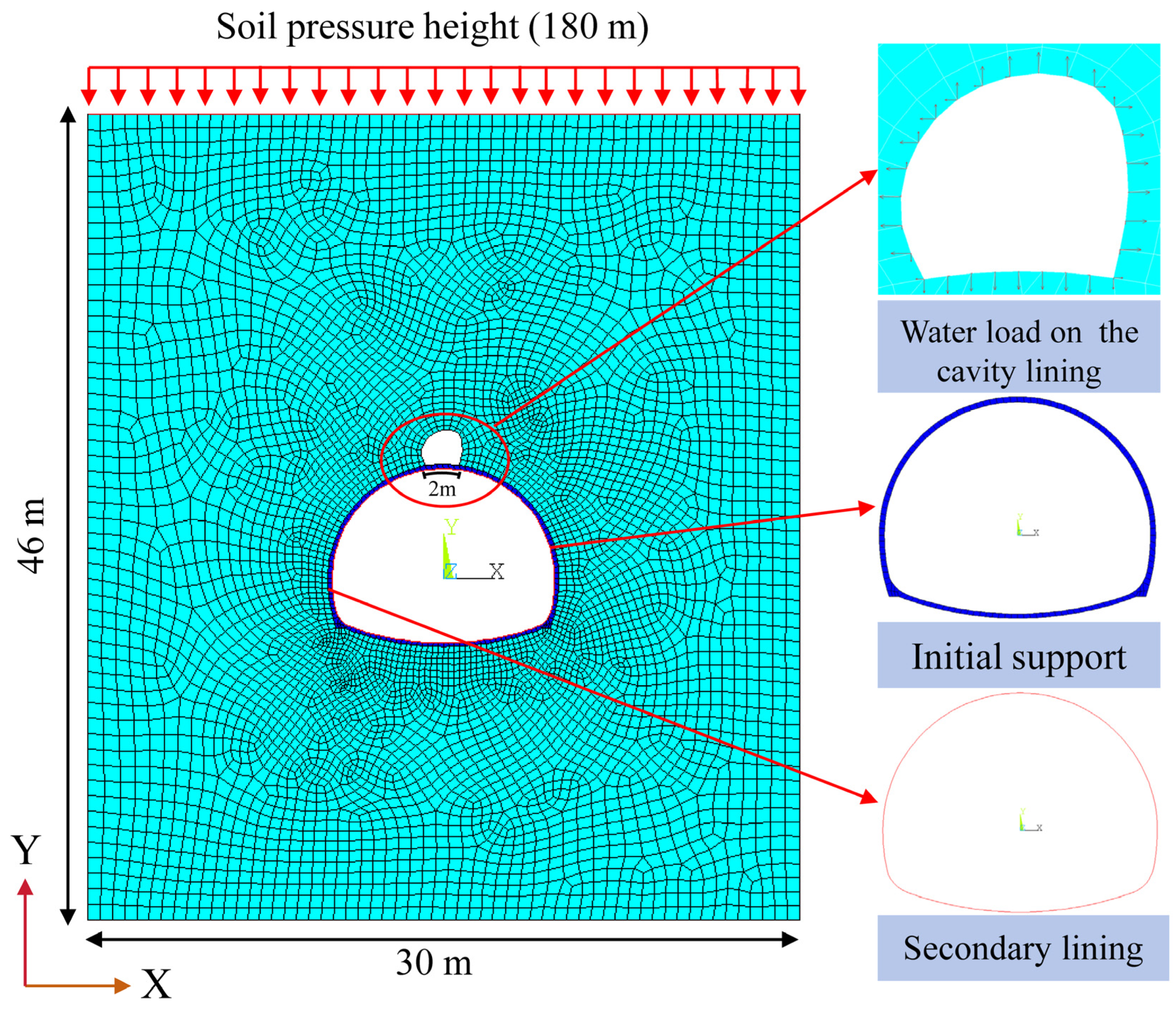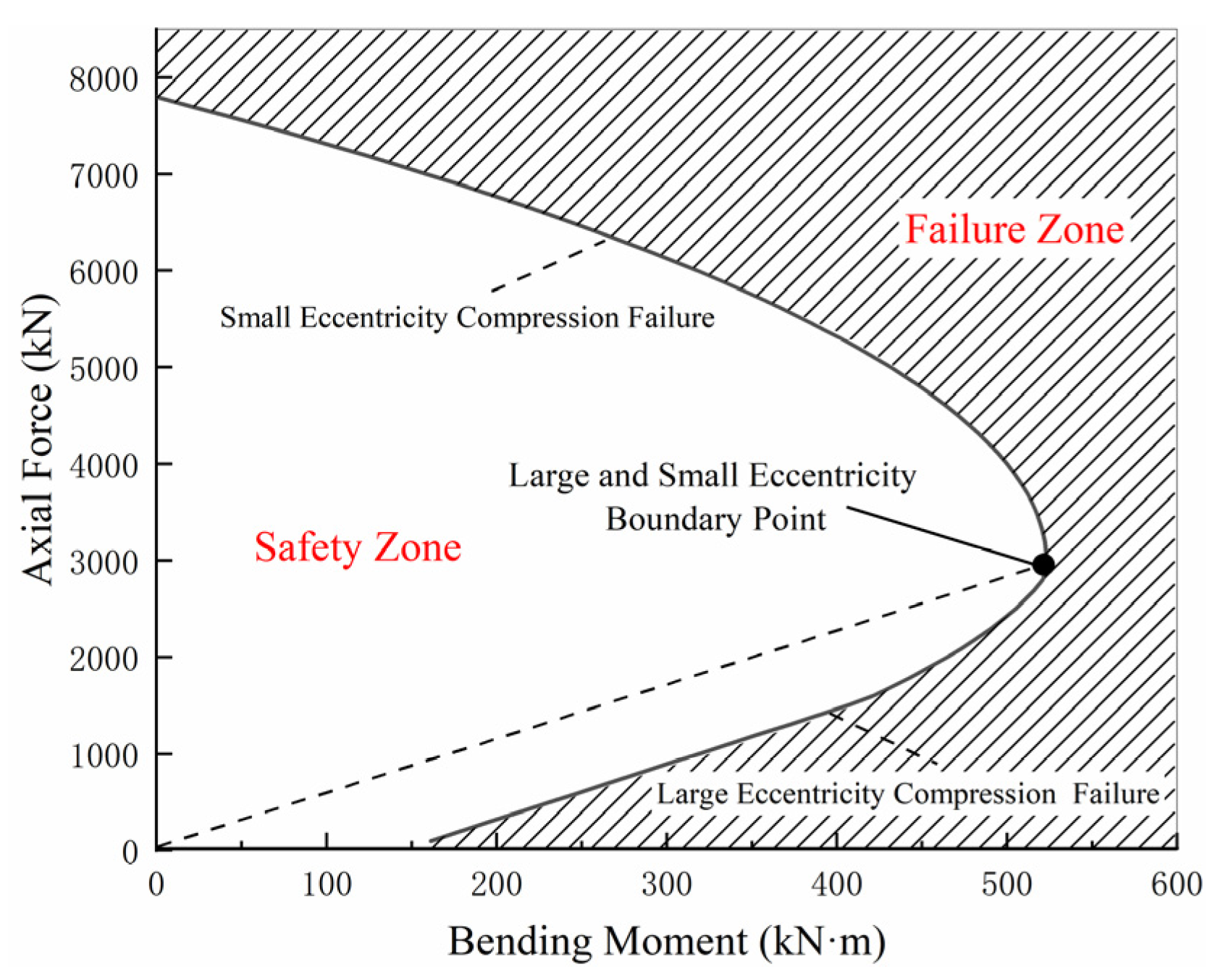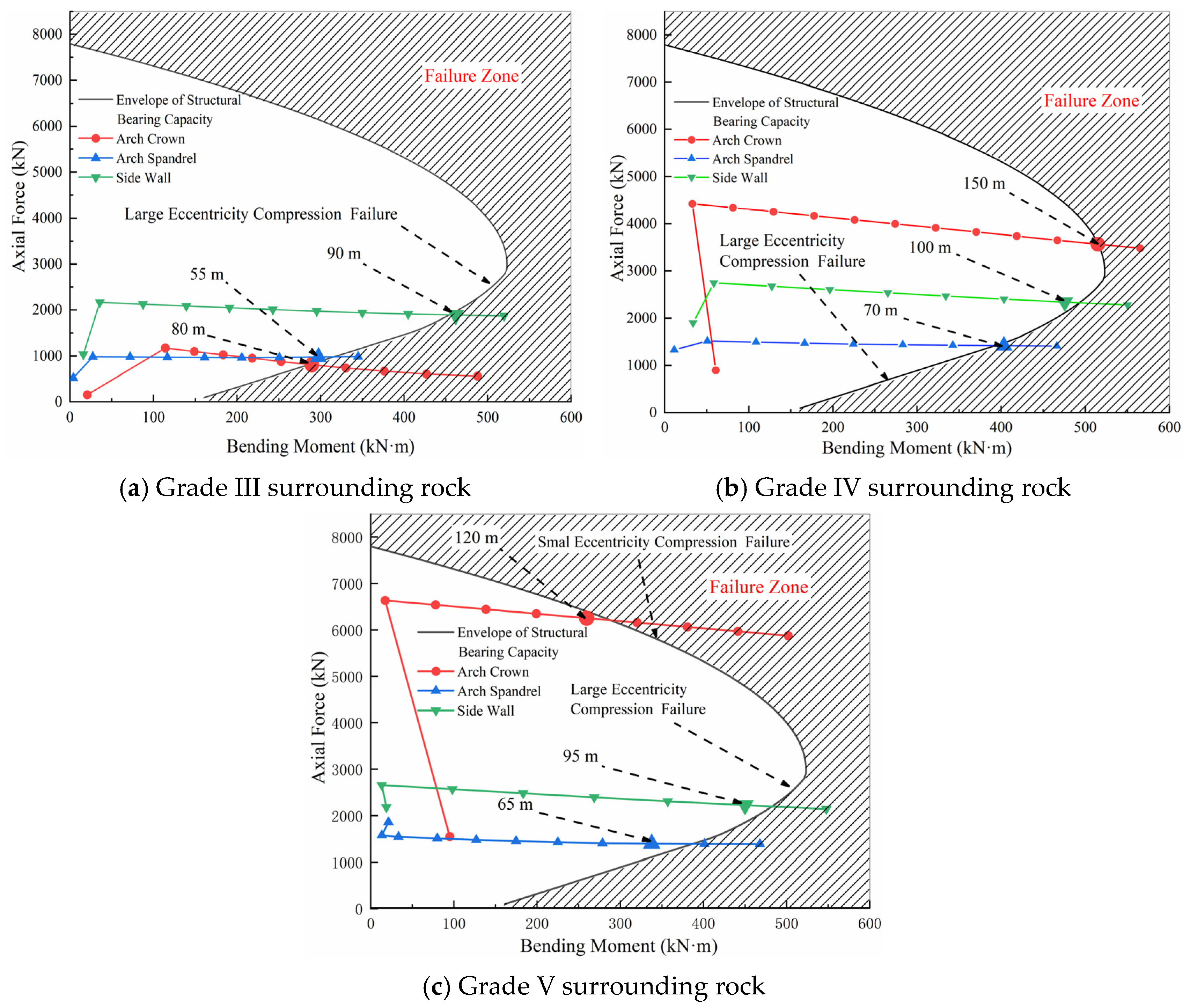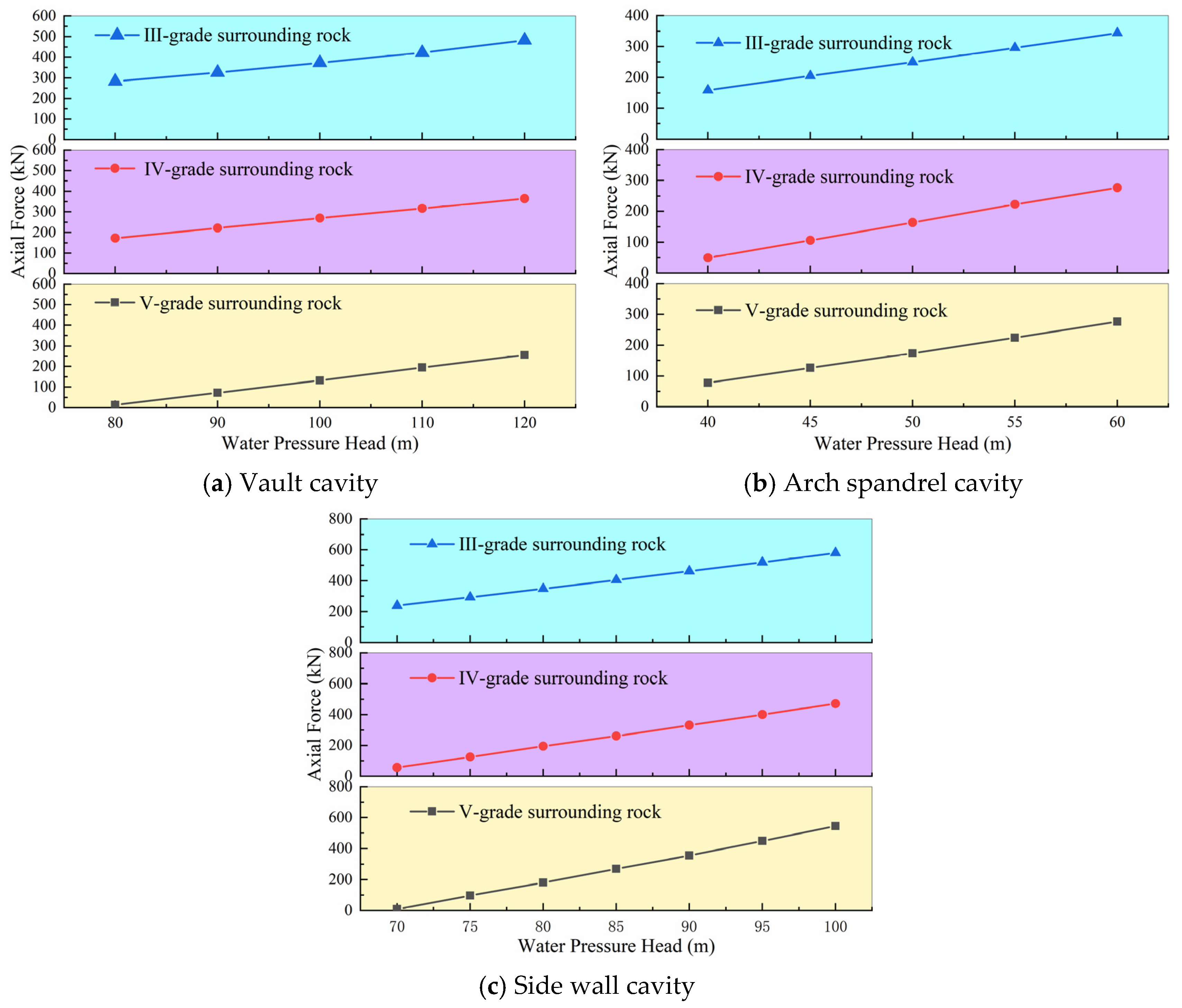Mechanical Characteristics and Safety Evaluation of Tunnel Lining Structures in Karst Areas Under Heavy Rainfall Conditions
Abstract
1. Introduction
2. Project Overview
3. Numerical Simulation
3.1. Numerical Model and Parameter Selection
- (1)
- Calculate the initial self-weight stress field.
- (2)
- Simulate tunnel excavation and stress release in karst areas to determine the ground stress field and structural stress characteristics upon completion.
- (3)
- Apply water pressure around the cavity boundary. An internal program calculates the pressure based on the designated water pressure height, and the corresponding nodal forces are then applied to the cavity boundary to simulate the water load.
3.2. Working Condition Design
3.3. Structural Safety Assessment Methods
4. Results Analysis
4.1. Structural Mechanical Response After Cavity Filling
4.2. Influence of Surrounding Rock Grade on Structural Stress
4.3. Influence of Cavity Position on Structural Stress
5. Critical Water Pressure Height of Structures Under Different Factors and Its Application
5.1. Determination of Critical Water Pressure Height and Failure Forms of Tunnels
5.2. On-Site Tunnel Construction and Design Optimization Solutions
6. Conclusions
- (1)
- Compared with the absence of karst conditions, water filling in karst cavity will lead to a sharp increase in the internal forces of the structure. When the water pressure inside the cavity is relatively small, it can restrain the bulging deformation of the structure into the cavity, which is more beneficial to the structure. However, as the water pressure increases, the internal forces of the structure gradually increase until it is damaged.
- (2)
- When the water pressure is the same, the lining structure bears the greatest bending moment in the grade III surrounding rock under different position conditions of the karst cave. Due to the dual nature of the surrounding rock’s effect on the structure as both load and constraint, the critical water pressure of the structure increases first and then decreases with the increase in the surrounding rock grade.
- (3)
- In terms of structural failure forms, when karst develops at the arch top position in grade IV and V surrounding rocks, the structure is damaged in the form of small eccentric compression, while the remaining surrounding rock grades and cave location conditions are all damaged in the form of large eccentric compression.
- (4)
- Due to the force symmetry and constraints of the structure, the critical water pressure value of the lining structure at the arch shoulder position is the smallest under different surrounding rock grades and should be closely monitored.
- (5)
- A safety assessment was conducted based on critical water pressure values under various influencing factors. Accordingly, corresponding construction measures were applied to improve the drainage efficiency of groundwater, and the thickness of the secondary lining was increased to improve the structural stability of the karst tunnel. Thus, the safety of karst tunnels can be guaranteed under heavy rainfall conditions.
- (6)
- In the future, the rationality of the critical water pressure height proposed in this paper will be explored through the method of indoor experiments. Meanwhile, research on the mechanical characteristics of the lining structure under the coupling effect of surrounding rock and groundwater is being further explored.
Author Contributions
Funding
Data Availability Statement
Conflicts of Interest
Nomenclature
| PLANE42 | A planar element in the ANSYS element library |
| C20 | The designed compressive strength of concrete is 20 MPa |
| C30 | The designed compressive strength of concrete is 30 MPa |
| SA3 | The secondary lining form of surrounding rock III |
| SA4 | The secondary lining form of surrounding rock IV |
| SA5 | The secondary lining form of surrounding rock V |
| SA5JQB | The secondary lining form of surrounding rock V in the reinforcement section |
References
- Huang, K.; Ma, Z.; Wang, X.; Shan, J.; Zhang, Z.; Xia, P.; Jiang, X.; Wu, X.; Huang, X. Control of soil organic carbon under karst landforms: A case study of Guizhou Province, in southwest China. Ecol. Indic. 2022, 145, 109624. [Google Scholar] [CrossRef]
- Jin, M.; Liu, X.; Zhong, Z. Study on the Mechanical Characteristics of the Lining Structure of the Karst Tunnel under the Action of Local High Water Pressure on the Vault. Chin. J. Undergr. Space Eng. 2021, 17, 1099–1105+1131. [Google Scholar]
- Li, T.; Zhang, L.; Jiang, Q.; Feng, C.; Zhao, R. Safe Thickness and Fracture Evolution Law Determined for Hydraulic Fracturing of Water-Resistant Rock Mass with Hidden Karst Based on GDEM. Tunn. Constr. 2021, 41, 67–76. [Google Scholar]
- Qian, W.; Wang, B.; Luo, D.; Xu, A.; Li, S. Experimental investigation and application on mechanical properties of tunnel linings under different blockage rates of drainage system in a karst tunnel. Tunn. Undergr. Space Technol. 2025, 157, 106359. [Google Scholar] [CrossRef]
- Yuan, B.; Liang, J.; Zhang, B.; Chen, W.; Huang, X.; Huang, Q.; Li, Y.; Yuan, P. Optimized reinforcement of granite residual soil via a cement and alkaline solution: A coupling effect. J. Rock Mech. Geotech. Eng. 2025, 17, 509–523. [Google Scholar] [CrossRef]
- Wang, J.; Lin, G. Study on the Characteristics of Secondary Lining Cracking under the Effect of Rheological Load. Mod. Tunn. Technol. 2020, 57, 83–90. [Google Scholar]
- Wan, F.; Li, K.; Wang, H.; Zhang, X. Analysis of Mechanical Characteristics of Karst Tunnel Lining Structure Under Heavy Rainfall. China J. Highw. Transp. 2023, 36, 312–322. [Google Scholar]
- Ding, W.; Liu, Y.; Wang, W.; Zhou, Y.; Li, H.; Rui, Y. Dynamic Risk Assessment of Water Inrush and Mud Burst in Tunnels Based on Fuzzy Two-dimensional Cloud Probability Model. Mod. Tunn. Technol. 2024, 61, 261–268. [Google Scholar]
- Sun, X.; Guo, X.; Si, N. Effects of Pipe-Type Hidden Caverns on Tunnel Lining Structure Under Strong Rainfall Conditions. Tunn. Constr. 2023, 43, 1831–1841. [Google Scholar]
- Bai, C. Research on Intelligent Prediction Method of Hazard Risk of Water and Mud inrush in Karst Tunnel Based on Machine Learning. Ph.D. Thesis, Shandong University, Jinan, China, 2021. [Google Scholar]
- Yu, H. Discussion on lining strength of railway tunnels in karst areas under instantaneous heavy rainfall: An example of the Yuanbaoshan tunnel of Zhijin-Bijie railway in Guizhou Province. Carsilogica Sin. 2019, 38, 916–923. [Google Scholar]
- Shang, H.; Zhen, B.; Guo, R. Structural Mechanical Response Caused by Water Pressure Change of Karst Water-rich Tunnel and Prevention Measures. Mod. Tunn. Technol. 2020, 57, 374–381. [Google Scholar]
- Yuan, Y. Design of Railway Tunnel Drainage Tunnel in the Stratum with Large Water Volume in the Karst Area with Large Depth. Chin. J. Undergr. Space Eng. 2021, 17, 834–839. [Google Scholar]
- Xu, Q.; Song, Y.; Fan, H.; Tan, X.; Yang, H. Model Test Study on Water Pressure Distribution Characteristics of Lining Structure in Water-Rich Karst Tunnel. China Railw. Sci. 2022, 43, 74–83. [Google Scholar]
- Bao, T.; Zhang, S.; Liu, C.; Xu, Q. Experimental Study on the Effect of Hydraulic Deterioration of Different Drainage Systems on Lining Water Pressure. Processes 2022, 10, 1975. [Google Scholar] [CrossRef]
- Zhang, C.; Liu, N.; Chen, K.; Ren, F. Study on drainage mode and anti-clogging performance of new waterproofing and drainage system in a tunnel. Sci. Rep. 2023, 13, 5354. [Google Scholar] [CrossRef] [PubMed]
- Teng, Z.; Liu, Y.; Zhou, Y.; Li, Y.; Mei, S.; Chen, Q.; Chen, L.; Du, B. Investigation of a new reverse drainage construction and the pressure-reducing effect of a tunnel in a water-rich karst location. Tunn. Undergr. Space Technol. 2024, 145, 105580. [Google Scholar] [CrossRef]
- Luo, Y.; Yang, J.; Xie, Y.; Fu, J.; Zhang, C. Investigation on evolution mechanism and treatment of invert damage in operating railway tunnels under heavy rainfall. Bull. Eng. Geol. Environ. 2024, 83, 160. [Google Scholar] [CrossRef]
- Yang, C.; Cui, Z.; Niu, F.; Wang, B. Influence Mechanism on Structural Safety by Tunnel Liner Diseases. J. Water Resour. Archit. Eng. 2023, 21, 180–186. [Google Scholar]
- Liu, H. The Interaction between Karst Cave Water Storage and Tunnel Lining in Complex Karst Area. Sci. Technol. Eng. 2020, 20, 9140–9148. [Google Scholar]
- Zheng, Y.; Abil, D. On Stability Analysis and Classification of Surrounding Rocks in Rock Tunnels. Mod. Tunn. Technol. 2022, 59, 1–13. [Google Scholar]








| Cavity Location | Circumferential Width of Cavity | Quantity |
|---|---|---|
| Arch crown | <1 m | 3 |
| 1 m~2 m | 2 | |
| 2 m~3 m | 0 | |
| Arch spandrel | <1 m | 4 |
| 1 m~2 m | 3 | |
| 2 m~3 m | 2 | |
| Side wall | <1 m | 4 |
| 1 m~2 m | 3 | |
| 2 m~3 m | 1 |
| Material | Element Type | Elastic Modulus (GPa) | Poisson’s Ratio | Density (kg·m−3) | Cohesion (MPa) | Internal Friction Angle (°) |
|---|---|---|---|---|---|---|
| Primary support | PLANE42 | 28.0 | 0.2 | 2200 | \ | \ |
| Secondary lining | Beam Element | 30.0 | 0.2 | 2300 | \ | \ |
| Surrounding rock III | PLANE42 | 12.0 | 0.25 | 2500 | 1 | 40 |
| Surrounding rock IV | PLANE42 | 3.0 | 0.32 | 2300 | 0.5 | 30 |
| Surrounding rock V | PLANE42 | 1.2 | 0.38 | 2000 | 0.14 | 24 |
| Influencing Factors | Working Condition Design | Remarks |
|---|---|---|
| Cavity location | Arch crown | Circumferential width: 2 m, 3 m |
| Arch spandrel | Circumferential width: 2 m, 3 m | |
| Side wall | Circumferential width: 2 m, 3 m | |
| Water pressure height | 0 m-ultimate water pressure height | / |
| Surrounding rock grade | III | / |
| IV | / | |
| V | / |
| Surrounding Rock Grade | Circumferential Width of Cavity (m) | Location of Cavity | Critical Water Pressure Height (m) | Destruction Mode |
|---|---|---|---|---|
| III | 2 | Arch crown | 70 | Large eccentric compression failure |
| Arch spandrel | 65 | |||
| Side wall | 70 | |||
| 3 | Arch crown | 60 | ||
| Arch spandrel | 55 | |||
| Side wall | 85 | |||
| IV | 2 | Arch crown | 140 | Small eccentric compression failure |
| Arch spandrel | 80 | Large eccentric compression failure | ||
| Side wall | 85 | |||
| 3 | Arch crown | 90 | ||
| Arch spandrel | 65 | |||
| Side wall | 100 | |||
| V | 2 | Arch crown | 120 | Small eccentric compression failure |
| Arch spandrel | 85 | Large eccentric compression failure | ||
| Side wall | 105 | |||
| 3 | Arch crown | 85 | ||
| Arch spandrel | 65 | |||
| Side wall | 95 |
| Number | Location and Size | Surrounding Rock Grade | Original Support Type | Have a Hydraulic Connection or Not | Safe or Not | Need to Change the Design or Not |
|---|---|---|---|---|---|---|
| K65 + 372 | Arch spandrel, diameter 2 m | IV | SA4 | No | Safe | Unnecessary |
| K65 + 327 | Arch waist, diameter 2 m | V | SA5 | No | Safe | Unnecessary |
| K65 + 324 | Arch waist, diameter 6 m | V | SA5 | Yes | Unsafe | Necessary |
| K65 + 310 | Arch waist, diameter 3 m | V | SA5 | Yes | Unsafe | Necessary |
| ZK65 + 314 | Arch waist, diameter 3 m | V | SA5 | Yes | Unsafe | Necessary |
| ZK65 + 240 | Arch spandrel, diameter 4 m | III | SA3 | No | Safe | Unnecessary |
| Tunnel Location | Conventional Section | Strengthening Section | Conventional Section | |
|---|---|---|---|---|
| Left Tunnel | Original design | SA3 (130 m) | SA5: ZK65 + 270~ZK65 + 330 (60 m) | SA4 (100 m) |
| Design after change | SA3 (130 m) | SA5JQB: ZK65 + 270~ZK65 + 330 (60 m) | SA4 (100 m) | |
| Right Tunnel | Original design | SA3 (140 m) | SA5: K65 + 290~K65 + 350 (60 m) | SA4 (100 m) |
| Design after change | SA3 (140 m) | SA5JQB: K65 + 290~K65 + 350 (60 m) | SA4 (100 m) | |
Disclaimer/Publisher’s Note: The statements, opinions and data contained in all publications are solely those of the individual author(s) and contributor(s) and not of MDPI and/or the editor(s). MDPI and/or the editor(s) disclaim responsibility for any injury to people or property resulting from any ideas, methods, instructions or products referred to in the content. |
© 2025 by the authors. Licensee MDPI, Basel, Switzerland. This article is an open access article distributed under the terms and conditions of the Creative Commons Attribution (CC BY) license (https://creativecommons.org/licenses/by/4.0/).
Share and Cite
Qian, W.; Tang, X.; Ma, X.; Wang, X. Mechanical Characteristics and Safety Evaluation of Tunnel Lining Structures in Karst Areas Under Heavy Rainfall Conditions. Buildings 2025, 15, 1756. https://doi.org/10.3390/buildings15101756
Qian W, Tang X, Ma X, Wang X. Mechanical Characteristics and Safety Evaluation of Tunnel Lining Structures in Karst Areas Under Heavy Rainfall Conditions. Buildings. 2025; 15(10):1756. https://doi.org/10.3390/buildings15101756
Chicago/Turabian StyleQian, Wangping, Xu Tang, Xiaoxin Ma, and Xiaonan Wang. 2025. "Mechanical Characteristics and Safety Evaluation of Tunnel Lining Structures in Karst Areas Under Heavy Rainfall Conditions" Buildings 15, no. 10: 1756. https://doi.org/10.3390/buildings15101756
APA StyleQian, W., Tang, X., Ma, X., & Wang, X. (2025). Mechanical Characteristics and Safety Evaluation of Tunnel Lining Structures in Karst Areas Under Heavy Rainfall Conditions. Buildings, 15(10), 1756. https://doi.org/10.3390/buildings15101756







